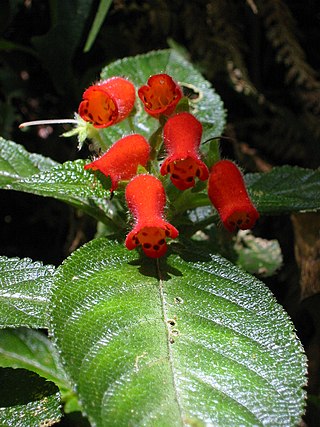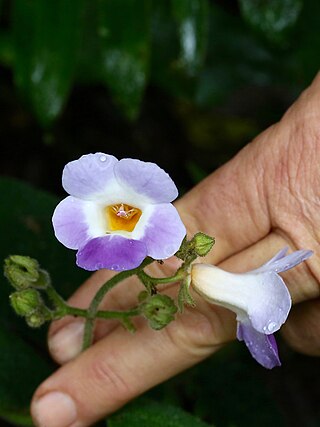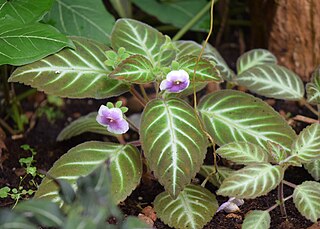
Nepeta is a genus of flowering plants in the family Lamiaceae. The genus name, from Latin nepeta (“catnip”), is reportedly in reference to Nepete, an ancient Etruscan city. There are 295 accepted species.

Gloxinia is a genus containing three species of tropical rhizomatous herbs in the flowering plant family Gesneriaceae. The species are primarily found in the Andes of South America, but Gloxinia perennis is also found in Central America and the West Indies, where it has probably escaped from cultivation.

Kohleria is a New World genus of the flowering plant family Gesneriaceae. The plants are generally tropical herbs or subshrubs with velvety stems and foliage and brightly colored flowers with spots or markings in contrasting colors. They are rhizomatous and commonly include a period of dormancy in their growth cycle. The genus was revised in 1992 and was then recognized as having 19 species distributed in Central America and South America. phylogenetic in 2005 indicated that the epiphytic genus Capanea is derived from within Kohleria, and the two species of Capanea were subsequently transferred to Kohleria. The genus Pearcea is closely related.

Seemannia is a New World genus in the flowering plant family Gesneriaceae. There are four species in the genus, primarily found in the Andean regions of South America. The name honors the German botanist Berthold Carl Seemann.

Pearcea is a genus of tropical herbaceous plants in the family Gesneriaceae native to western South America. It is classified in tribe Gloxinieae and is closely related to the genus Kohleria, in which some of its species were previously included. The genus Parakohleria has recently been synonymized under Pearcea, a conclusion later supported by molecular analyses that showed that Pearcea hypocyrtiflora was nested within the former Parakohlerias.
Benjamin Peter Gloxin (1765–1794) was a German physician and botanical writer who lived in Colmar. He is commemorated by the Brazilian genus Gloxinia and Sinningia speciosa, which is commonly called Gloxinia in the horticulture trade. In 1791, he was elected to the American Philosophical Society.

Fagraea is a genus of plants in the family Gentianaceae. It includes trees, shrubs, lianas, and epiphytes. They can be found in forests, swamps, and other habitat in Asia, Australia, and the Pacific Islands, with the center of diversity in Malesia.

Monopyle is a genus of plants in the family Gesneriaceae.
Phinaea is a genus of flowering plants in family Gesneriaceae. It contains three species native to the Americas, including western and central Mexico, Cuba and Haiti, and Colombia and northern Brazil.

Salsola is a genus of the subfamily Salsoloideae in the family Amaranthaceae. The genus sensu stricto is distributed in central and southwestern Asia, North Africa, and the Mediterranean. A common name of various members of this genus and related genera is saltwort, for their salt tolerance. The genus name Salsola is from the Latin salsus, meaning "salty".

Jean Jules Linden was a Belgian botanist, explorer, horticulturist and businessman. He specialised in orchids, which he wrote a number of books about.

Lumnitzera is an Indo-West Pacific mangrove genus in the family Combretaceae. An English common name is black mangrove. Lumnitzera, named after the German botanist, Stephan Lumnitzer (1750-1806), occurs in mangroves from East Africa to the Western Pacific, and northern Australia.
Amalophyllon is a genus of flowering plants belonging to the family Gesneriaceae. It includes 13 species native to the tropical Americas, ranging from southern Mexico through Central America to Venezuela and Peru.
Bejaria is a genus of flowering plants belonging to the family Ericaceae.
Cladocolea is a genus of flowering plants belonging to the family Loranthaceae.

Gloxinella is a monotypic genus of flowering plants belonging to the family Gesneriaceae. It only contains one species, Gloxinella lindeniana(Regel) Roalson & Boggan
Mandirola is a genus of flowering plants belonging to the family Gesneriaceae.
Nomopyle is a genus of flowering plants belonging to the family Gesneriaceae.
Sphaerorrhiza is a genus of flowering plants belonging to the family Gesneriaceae.
Neuropeltis is a genus of flowering plants belonging to the family Convolvulaceae.











